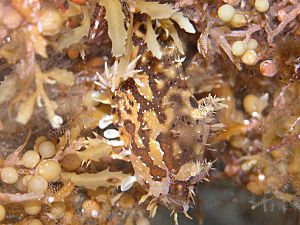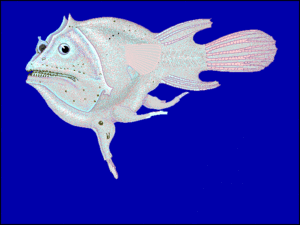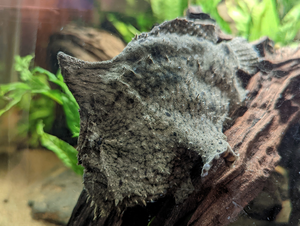Anglerfish facts for kids
Quick facts for kids Anglerfish |
|
|---|---|
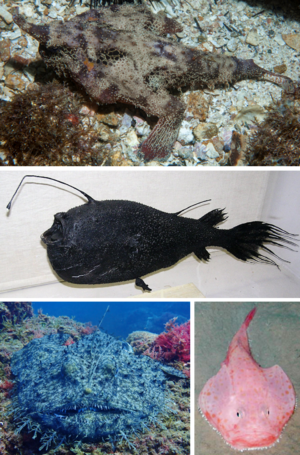 |
|
| Type species of 4 lophiiform suborders | |
| Scientific classification |
|
| Kingdom: | Animalia |
| Phylum: | Chordata |
| Class: | Actinopterygii |
| Clade: | Percomorpha |
| Order: | Lophiiformes Sedgwick et. al., 1905 |
| Type species | |
| Lophius piscatorius Linnaeus, 1758
|
|
| Synonyms | |
|
Pediculati Müller, 1839 (pro parte) |
|
The anglerfish are fascinating ray-finned fish that belong to the order Lophiiformes. Both their common name and scientific name come from their special way of hunting. They use a modified fin ray as a "fishing rod" to attract prey.
This unique "fishing rod" is called the illicium. Its very tip, known as the esca, acts like a lure. Different types of anglerfish have different lures to attract specific prey.
Anglerfish live all over the world. Most of them are bottom-dwellers, meaning they live on the seafloor. However, some deep-sea anglerfish swim freely in the open ocean. You can find anglerfish in the deep sea, like the deep-sea anglerfish and sea toads. Others live in shallower waters, such as the frogfishes and some batfishes.
Anglerfish are also known for their striking differences between males and females. Males can be much, much smaller than females. This difference allows for a very unique way of reproduction in deep-sea anglerfish. The male attaches to the much larger female, sometimes staying connected for life.
Contents
Anglerfish Family Tree: Classification
Scientists group anglerfish into different families and suborders. This helps us understand their relationships. The classification below is based on Eschmeyer's Catalog of Fishes (2025).
- Suborder Lophioidei
- Family Lophiidae (monkfishes and goosefishes)
- Suborder Ogcocephaloidei
- Family Ogcocephalidae (batfishes)
- Suborder Antennarioidei
- Family Antennariidae (frogfishes)
- Subfamily Fowlerichthyinae (fanfin frogfishes)
- Subfamily Antennariinae (Fibonacci frogfishes)
- Subfamily Lophichthyinae (lophichthyin frogfishes)
- Subfamily Tathicarpinae (longfin frogfishes)
- Subfamily Tetrabrachiinae (tetrabrachiid frogfishes)
- Subfamily Histiophryninae (starfingered frogfishes)
- Subfamily Rhycherinae (Balrog frogfishes)
- Subfamily Brachionichthyinae (handfishes)
- Family Antennariidae (frogfishes)
- Suborder Chaunacoidei
- Family Chaunacidae (gapers or sea toads)
- Suborder Ceratioidei
- Family Caulophrynidae (fanfins)
- Family Neoceratiidae (spiny seadevils)
- Family Melanocetidae (black seadevils)
- Family Himantolophidae (footballfishes)
- Family Diceratiidae (double anglers)
- Family Oneirodidae (dreamers)
- Family Thaumatichthyidae (wolftrap anglers)
- Family Centrophrynidae (prickly seadevils)
- Family Ceratiidae (warty seadevils)
- Family Gigantactinidae (whipnose anglers)
- Family Linophrynidae (leftvents)
Anglerfish are closely related to Tetraodontiformes, which include pufferfish. Both groups share special features. These include small gill openings and missing certain bones.
The History of Anglerfish: Evolution
The oldest anglerfish fossils are from the Eocene epoch. These fossils, found in Italy, already show many different types of anglerfish. This suggests they started evolving much earlier.
Scientists believe anglerfish likely first appeared during the Cretaceous period. This was between 130 and 100 million years ago. Other studies suggest they diversified more recently, after a major extinction event.
A 2024 study showed that all anglerfish suborders probably separated during the Late Cretaceous and Paleocene. The deep-sea anglerfish families, with their unique mating, developed during the Eocene. This happened after a warm period called the Paleocene–Eocene Thermal Maximum. Adapting to different ocean depths likely helped anglerfish evolve.
Anglerfish fossils appear in the timeline below:

Anglerfish Body Features: Anatomy
Anglerfish have several unique body features. Their gills open behind their pectoral fins, unlike most other fish. They also have special teeth that can fold backward. This helps prey slide in easily but prevents escape.
Anglerfish come in many sizes. Some are as small as 2 centimeters (less than an inch). Others can grow over 100 centimeters (about 3 feet) long. The European monkfish can reach 200 cm (6.5 ft) and weigh 57.7 kg (127 lbs).
Many anglerfish species show big differences between males and females. Deep-sea anglerfish are the most extreme example. A female Ceratias holboelli can be 77 cm (2.5 ft) long. Her male partner might be only 16 cm (6 inches).
Anglerfish are usually ambush predators. Shallow-water species, like frogfish, often blend in with rocks, sponges, or seaweed. Deep-sea anglerfish are dark-colored, from gray to brown. This helps them hide in the dark depths.
Anglerfish have wide mouths that can open very far. Their jaws and stomachs can stretch to enormous sizes. This allows them to swallow prey up to twice their own body size. Their bones are thin and flexible to help with this.
The Special Lure: Esca and Illicium
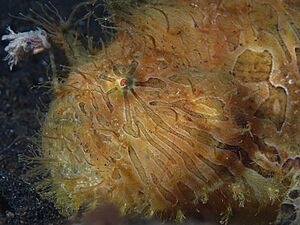
All anglerfish are meat-eaters and are built for catching prey. They all have a "lure" or "bait" called the esca. The esca is the tip of a modified fin ray. This fin ray is often called the "fishing rod" and is scientifically named the illicium.
The illicium can be very short or incredibly long. In some species, it can be over four times the length of the rest of the body. Both the esca and illicium work together to attract prey.
The deep-sea anglerfish are famous for their glowing esca. This glow comes from bioluminescent bacteria living inside the esca. It helps them attract prey in the dark deep ocean. Other anglerfish use different lures. Some batfish might release chemicals that attract prey by smell. Frogfish lures can look like small shrimp or worms. When prey gets close, the anglerfish quickly sucks it in or grabs it with sharp teeth.
Anglerfish Life: Behavior
Hunting Strategies
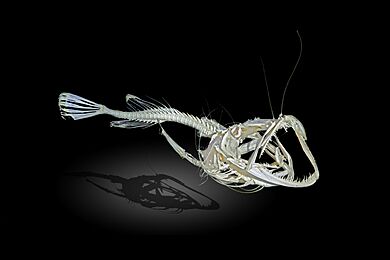
The name "anglerfish" comes from their unique hunting method. They have a long filament, the illicium, growing from their heads. This illicium is made from modified dorsal fin spines.
The first spine is usually the longest and has a fleshy growth, the esca, at its tip. Anglerfish can wiggle this esca to make it look like a small animal. This tricks other fish into coming closer. Once the prey is near, the anglerfish quickly devours it. Deep-sea anglerfish also use their glowing esca to attract prey in the dark.
Anglerfish are opportunistic hunters, meaning they eat whatever they can find. They eat a variety of prey, from small fish to crustaceans. One study found that threadfin anglerfish mostly ate shrimp and other fish. Many anglerfish stomachs were empty, showing they don't need to eat constantly.
Moving and Saving Energy
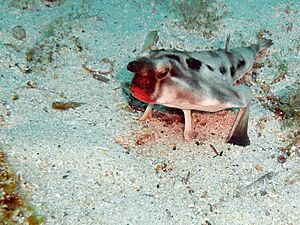
Anglerfish are not strong swimmers. Demersal species, which live on the bottom, often "walk" using their pectoral and pelvic fins. Deep-sea anglerfish have lost their pelvic fins.
Deep-sea anglerfish often drift with ocean currents. Scientists have observed them floating in place. They only swim actively when trying to escape danger. This slow behavior helps them save energy in the deep sea, where food is scarce.
Their ability to stretch their jaws and stomach helps them eat large meals. This is important because food is limited in their environment. It allows them to store food when they find it.
Sea toads have been seen holding water in their gills for several minutes. This behavior might be a way to save energy. Breathing requires energy, so "holding their breath" could be beneficial.
Anglerfish Reproduction
Deep-sea anglerfish have a very unusual way of mating. Because it's hard to find a partner in the vast, dark ocean, the much smaller male anglerfish permanently attaches itself to a female. They join together, and the male receives nutrients from the female. This unique bond helps them reproduce successfully in their challenging environment.
When scientists first found deep-sea anglerfish, they noticed small "parasites" on the females. These turned out to be the tiny males. This special connection is one of nature's most unique partnerships.
All anglerfish eggs are covered in a jelly-like layer. The eggs of Lophius anglerfish can be in a thin, transparent sheet. This sheet can be 25 cm (10 inches) wide and over 10 meters (33 feet) long. It can hold more than a million eggs. The eggs are in a single layer, each in its own space. The young larvae float in the open ocean. This helps spread them over a large area.
Adaptations
Anglerfish have developed many special features to help them survive and thrive in their diverse environments.
1. In the pitch-black deep sea, where sunlight can't reach, the esca of many deep-sea anglerfish glows! This glow comes from tiny, friendly bacteria that live inside the esca. The light attracts other curious fish or small creatures, thinking it might be something good to eat. When the unsuspecting prey gets close enough... chomp! Anglerfish living in shallower waters don't usually have glowing lures. Instead, their esca might look like a tasty shrimp, a wiggling worm, or even a piece of seaweed. This helps them blend in and trick their prey. Some might even release special smells to attract food!
2. Anglerfish have incredibly wide mouths that can open all the way around the front of their heads. Their jaws are lined with sharp, inwardly pointing teeth. These teeth can bend backward, allowing prey to slide easily into their stomach, but making it impossible for them to escape! One of the most amazing adaptations is their ability to stretch their jaws and stomachs to an enormous size. Their bones are thin and flexible, which means they can swallow prey that is up to twice as large as their entire body! This is super important in places like the deep sea where food is scarce. If they find a big meal, they can eat it all and store the energy for a long time.
3. Shallow-water anglerfish, like frogfish, are experts at blending in. They often look like rocks, sponges, or seaweed, waiting patiently for an unsuspecting meal to swim by. Deep-sea anglerfish are usually dark-colored (grey or brown) to blend in with the featureless darkness of their home. They are also not very strong swimmers. Instead of chasing food, they often just drift in the water, saving energy. This "sit and wait" strategy is perfect for the deep sea, where energy is precious.
4. Some anglerfish, like the sea toad, have been observed holding water in their gills for several minutes! Scientists think this might be a way to save energy because breathing uses up a lot of power. It's like holding your breath to conserve energy!
5. When anglerfish lay their eggs, they are often wrapped in a thin, jelly-like sheet that can be very long – sometimes over 30 feet! This "egg mass" can contain over a million eggs and helps spread the baby anglerfish over a wide area as it drifts through the ocean.
Anglerfish are truly one of nature's most incredible examples of adaptation, showing us how life can find amazing ways to survive and thrive in even the most challenging environments!
Anglerfish and Humans
Anglerfish as Food
Monkfish, a type of anglerfish, are caught for food in many parts of the world. This includes Europe, North America, Africa, and East Asia. In Europe and North America, the tail meat of Lophius species is popular. Many people compare its taste and texture to lobster.
In Japan, monkfish liver, called ankimo, is a special dish. Anglerfish is also very popular in South Korea. It is the main ingredient in dishes like Agujjim.
Some Lophius species in Northwest Europe are heavily fished. Environmental groups like Greenpeace have listed certain anglerfish species as "red list" seafood. This means they are likely caught in ways that harm the environment.
Anglerfish in Aquariums
Some shallow-water anglerfish, like frogfish and batfish, are kept in aquariums. However, deep-sea anglerfish are not kept in captivity. It is very difficult to catch them and keep them alive. They need special conditions, like high water pressure, that are hard to recreate.
Antennarius biocellatus, also known as the brackish-water frogfish, is unique. It can live in freshwater for some time. This species is sometimes kept in home aquariums by private fish enthusiasts.
Cool facts about anglerfish
- Scientists believe anglerfish first appeared a very long time ago, possibly during the Cretaceous period, which was when dinosaurs roamed the Earth!
- The oldest anglerfish fossils found are from about 56 to 34 million years ago in Italy.
- Even ancient Greek thinkers like Aristotle, over 2,000 years ago, wrote about the "Fishing-Frog" (a type of monkfish), noting its clever way of catching prey with its lure.
- Because some anglerfish species are heavily fished, groups like Greenpeace have put them on a "red list" to show that they might be caught in ways that aren't good for the ocean's health. It's important to make sure we fish responsibly to protect these amazing creatures.
- You can sometimes see shallow-water anglerfish, like frogfish and batfish, in public aquariums. However, deep-sea anglerfish are almost impossible to keep in captivity because they need the extreme pressure and cold temperatures of their deep-sea homes.
See also
 In Spanish: Lophiiformes para niños
In Spanish: Lophiiformes para niños


